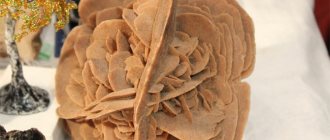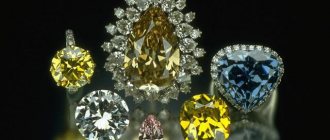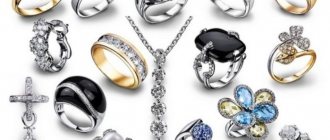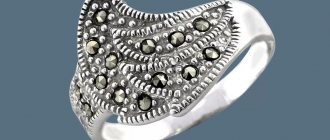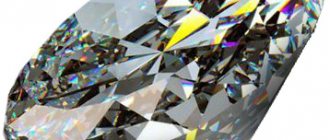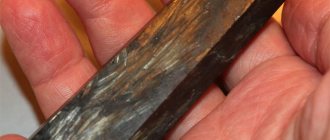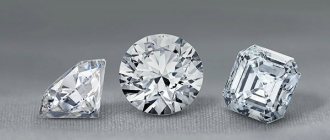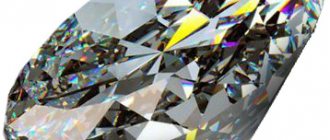The antique diamond market distinguishes several types of cuts inherent to a particular era. Antique cuts include diamonds that were mined and processed between 1300 and 1930. During a certain historical period, stones were processed using the method accepted at that time.
The first diamonds, found in India more than 3 thousand years ago, were not processed and were kept as sacred relics. Beginning in the 11th century, diamonds began to be worn as jewelry, but the stones were not cut. Then the gems began to be polished, giving them shine. Initially, only one surface of the crystal was polished, the finish was called “table” or table cut (Table Stone). The world's largest pink diamond, Daria-E-Nur, and the most mysterious diamond, the Shah Jahan, which is kept in the Diamond Fund of Russia, are cut in this way.
There was very little diamond jewelry. Only crowned heads could afford to wear such rare jewelry.
The rose cut is back
Diamond is the hardest mineral in nature. To process it, an equally hard material is required. When they realized that a nugget could be processed with the same stone, the era of new types of cutting began. Since 1477, the fashion for engagement rings has been established, when the Austrian Archduke gave his beloved a ring with a diamond inlay of the letter “M”. The bride's name was Maria. The tradition of giving a diamond ring on the day of engagement continues to this day.
Then the cutter's tools began to appear and improve. The rose cut, which has 3-24 facets, dates back to the 16th century. The stone is ground along a curved surface, resulting in a diamond with a flat bottom and a dome-shaped crown. Hollywood film star Jennifer Aniston received a ring with a diamond of this cut on her engagement day in 2012. Since there are no spherical diamonds in nature, the stone loses a lot of weight during this treatment. It is important for the jeweler to preserve the original weight of the nugget as much as possible. The greater the mass of the diamond, the higher its value.
What does an uncut diamond look like?
Diamond cutting changes the natural gem dramatically. If you compare the crystal before and after the process, it is difficult to believe that it is the same stone. Giving it shape and edges makes it shine and shimmer with all the colors of the rainbow, giving it transparency.
Before cutting, a diamond looks completely different from a processed mineral:
- uneven shape;
- no shine;
- there may be inclusions, impurities;
- dark or black.
Uncut diamonds are not in mass demand, although there are individual collectors who purchase just such stones, but these are isolated cases.
17th century cutting
At the beginning of the 17th century, in diamond mines in Brazil, gems were cut in such a way that the girdle took the shape of a pillow. The corners of the processed diamond were rounded, the stone looked larger. Shaft or cushion processing preserved the diamond from chipping at the corners. The previous table cut looked boring and was impractical. After the discovery of diamond deposits in South Africa, this type of diamond finishing became known as “old mine cutting.” As a result of grinding, the original weight of the nugget is preserved as much as possible. An improved form of the shaft cut is the cushion type with 57 facets: 33 in the crown and 24 in the pavilion.
LiveInternetLiveInternet
This is the processing of precious stones to give them a certain shape and maximize their play and brilliance. The main faces of the stone have their own names. The upper horizontal edge is called a table or platform, and the lower small, also horizontal, edge is called a tunic. If there is no tuft, the stone ends in a spike at the bottom. Around the table there are inclined edges and, which are called the crown, the belt of inclined edges around the tunic is called the pavilion. And finally, the belt of narrow vertical edges separating the crown and the pavilion is called the girdle, or rim. The following forms (or types) of gemstone cutting are common: diamond; stepped (emerald, baguette) - for rectangular or trapezoidal stones; special or fancy forms; marquise (<shuttle>) - elongated, with pointed ends; pear, pandelok - asymmetrical, elongated in one direction, with one pointed end. Often used as pendants. Pandeloks are usually more elongated than pears; briolette (<drop>) - used as pendants in earrings and other products; wedges - used for relatively large transparent stones of classes II and III; cabochon - a smooth, convex cut without sharp edges or edges, usually used for opaque or densely colored stones. Not applicable for diamonds; rose - an ancient cut with a flat bottom, now sometimes used for small diamonds; table - a type of cut of a flat stone with a large polished top surface.
Faceted stones consist of the following parts. The girdle is the edge or tip of the stone that forms its perimeter. This is the end where the upper and lower parts of the stone meet, that is, in fact, a kind of dividing line. This is where the frame is usually fixed. The crown is the top part of the stone located above the girdle. The pavilion is the lower part of the stone, in other words, that part of the stone that is located below the girdle down to its lowest point. The kaleta is the lowest point of the stone. When examining a number of stones, you may not see it, which probably indicates a possible defect, but with regard to colored stones, a question may arise about the design of the cut. The platform (or table) is the flat top face of the stone, and it is also its largest face, sometimes called the face. The term "plate size" is used to describe the width of this facet, which is often expressed as a percentage of the total width of that stone.
Diamond cut. Of all the cut shapes, round diamonds are the most popular, perhaps due to their strong “play” and greater return of white light to the observer than other cuts. When creating a round cut, the yield from a diamond is significantly less than in the case of other cuts. This, along with the high popularity of round diamonds, are two main reasons for the relatively high cost of these stones. The round cut sets the standard for other shapes and accounts for over 75% of all diamonds sold to date. This 57 (58)-sided shape consists of a crown (top), girdle (widest part) and pavilion (bottom). To achieve maximum play in a round diamond, certain proportions must be strictly maintained. Common fantasy forms.
Fancy cut diamond shapes can be divided into two groups: wedge, in proportions close to a round diamond (marquise, pear, oval, heart, princess, radiant, etc.) and stepped (emerald, baguette, etc.). The step cut is composed of tiers (steps). Fancy wedge cut diamonds: marquise, pear, oval, can sometimes have a “bow tie” effect. Its appearance is associated with deviations in the proportions of the cut and symmetry of the stone. This effect negatively affects the appearance of the diamond, as a large dark highlight (spot) in the shape of a “bow tie” appears on the surface. Emerald cut is a step cut with an octagonal shape of the stone.
Marquise is a boat-shaped wedge cut. Awnings are often chosen by women who have an independent style. This elongated shape creates the effect of long and narrow fingers.
Pear is a drop-shaped wedge cut. These attractive diamonds are often used in pendants and earrings. Many of the largest stones ever found were cut into pears. Both large and small diamonds are cut in the shape of a pear. A large single pear-shaped diamond set in a ring visually lengthens the fingers.
Oval is a wedge cut with an oval outline. More often, this form is used for cutting large diamonds for setting in rings, earrings and pendants. A large single oval-shaped diamond set in a ring visually lengthens the fingers.
Step cut is a type of cut in which the facets are located one above the other, the shape of the top platform is a polygon, and the side faces are in the shape of trapezoids or isosceles triangles.
Princess – wedge cut square or rectangular with sharp corners. The cut has a very good game and a high degree of brilliantness. This relatively new cut with many sparkling facets is often used as single pieces in rings, earrings and pendants. Often the princess in rings is accompanied by trilliants on both sides. To increase the play of the stone, it is necessary to significantly increase the depth of the pavilion to 70-78%. While most square and rectangular cuts cannot match the sparkle of a round diamond, the Princess was specifically designed to approximate the sparkle of a round diamond. When purchasing a princess cut diamond piece, you need to ensure that the setting protects the four corners of the stone that are most susceptible to chipping.
The Asscher cut is a type of emerald cut that has a square shape and more tiers. The usher allows the wearer to look elegant and majestic. This Art Deco cut style combines old-fashioned charm with modern cutting technology to create a dazzling diamond. Ashers with equal length and width are preferred. This ratio should not exceed 1.1:1.
This is a square or rectangular wedge cut with an octagonal outline. Radiant combines the elegance of emerald with brilliant and the play of a round brilliant. To achieve greater play of the stone, it is necessary to increase the depth of the pavilion during cutting, which in turn entails an increase in the weight of the stone. The radiant cut is more often used for cutting single large stones. The radiant form can enhance the color of fancy colored diamonds. Heart is a wedge cut with an outline in the shape of a heart, the main symbol of love. It is essentially a pear-shaped diamond, split from the head side (see Cutting Elements). When purchasing such a diamond, you should pay attention to the evenness and clarity of the outlining line, since the beauty of this cut, like no other, directly depends on the qualifications of the cutter. Hearts are usually equal in length and width.
Cabochon (from the French caboche - head) is a method of processing a precious or semi-precious stone, in which the stone acquires a smooth convex polished surface without edges, in contrast to a faceted cut; as well as stone processed in this way. Typically, a polished cabochon has an oval or spherical shape, flat on one side. In a broader sense of the word, cabochon refers to the polishing of precious and semi-precious stones, as opposed to cutting.
Rose cut is a faceted cut without a platform or lower part. Depending on the number and shape of the facets, there are varieties - Dutch rose, Antwerp rose, half-Dutch rose, double Dutch rose and others. Various variations of the rose cut have been used since the 16th century. The base of the stone in this case is flat, and the crown consists of triangular faces, usually 12 or 24, arranged symmetrically. As a rule, the stone has a round shape. The exceptions are the briolette, Antwerp rose and double Dutch rose cut types. The rose cut is not often used in modern jewelry, but was very popular in the past.
Table cut or table cut is the simplest type of step cut with two “steps” - upper and lower. The upper part of the stone is made very flat to increase the platform - the “tablet”. Table cut was widely used by ancient Indians. It appeared in Europe in the second half of the 14th century. in Nuremberg. There are many varieties of table cuts, among which the Mazarin and Peruzzi cuts, common in France in the 17th century, deserve special attention. Nowadays, the table cut is used to create very thin shapes; Stones cut in this way are used as caps for miniatures set into rings. These stones are often called portrait stones.
The following 4 options are less common: cushion, flanders, alfalfa, jubilee.
